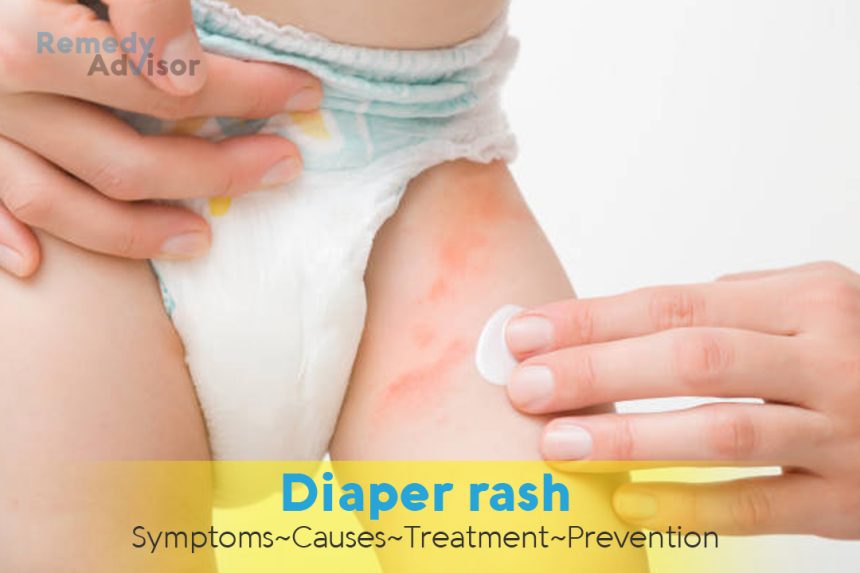What is it
Diaper rash is irritation of the skin from a moist diaper. Most babies get it occasionally, even very well cared-for babies with normal, healthy skin. (Diapering is a way to make infants manageable and socially acceptable, but in fact it inevitably causes diaper rash. In societies that don’t diaper, diaper rash is unknown.)
Most diaper rashes can be classified as simple contact dermatitis, though others can become complicated by fungal infections. Diaper rash is not contagious, but it can recur. As babies age, their skin grows less sensitive, and diaper rash is apt to be less of a problem.
Symptoms
- Rough, red patches of skin on the buttocks, upper thighs, genitals, or other areas over which a diaper is worn.
- The rash may be accompanied by the smell of ammonia.
What causes it
A wet or soiled diaper keeps the skin moist and traps urine, which can react with the bacteria in a baby’s feces to produce strong skin irritants, including ammonia. Diaper rash can also occur as a reaction to new foods or to chemicals, such as fragrances found in some lotions, creams, detergents, disposable diapers, or other products. Breast-feeding may offer some protection against diaper rash, perhaps because breast-fed babies have fewer irritants in their urine and feces, though breast-fed babies also get diaper rash.
What if you do nothing
Diaper rash may be irritating and unpleasant for the child. Without proper care, it is unlikely to get better, and it can also lead to more serious complications, such as bacterial or fungal (yeast) infections.
Home remedies
Most diaper rashes go away after several days with proper home care. Improvement should be noted in a day or two, with complete clearing of the rash by the third or fourth day. Homecare measures are simple and effective.
Change diapers frequently
Even more frequently than usual. This will discourage any moisture buildup. To avoid further irritating a rash, rinse the baby’s bottom instead of wiping. That is, pour water from your hand or a small container. Then, pat the area gently with cotton or tissue to dry it; don’t use a hair dryer for this purpose, since it can easily lead to accidental bums. Also, you should not wash a baby under running water, since the water temperature might suddenly change.
Allow the affected area to air
Although it may be messy, allow the baby to go diaper less for an hour or more each day. If you’re using cloth diapers, leave the plastic pants off as much as possible. Avoid plastic-coated disposable diapers or plastic pants. These measures wall encourage air circulation to the affected areas.
Apply ointment
When diapering, apply petroleum jelly or zinc oxide ointment to protect the skin from irritants in urine and feces. You’ll find many popular products, such as Desitin or A and D Ointment, on the drugstore shelf, although these preparations, including those containing vitamins, do not appear to perform any better than plain zinc oxide or petroleum jelly, which are cheaper. Avoid ointments, however, if the skin is severely inflamed or cracked.
Prevention
Along with other advantages they enjoy, among them reduced illness and infection, breastfed babies have less trouble with diaper rash possibly because they have fewer irritants in their urine and feces. So, breast-feeding mothers are already a step ahead. But even a breast-fed baby can get a rash. Here are ways to head it off.
Keep the bottom dry
Diapers should be changed as soon as possible when they are wet or soiled to keep the baby’s bottom dry. Newborns, however, urinate about 20 times a day (dropping to an average of 6.5 times at 12 months). And most newborns have a bowel movement after each feeding. Obviously, you cannot change diapers every hour around the clock, but you should aim to keep the baby as dry and clean as you can.
Gently wash the diaper area
Use plain water, and pat dry. It’s not necessary to use soap which may be irritating during diaper changes. Also, no ointments or creams are needed on healthy skin.
If you use disposable diapers, use superabsorbent ones
Disposable diapers constructed with a highly absorbent middle layer keep the skin drier and retain more urine at the center, away from the skin, than conventional disposable or cloth diapers. This should not discourage parents from using cloth diapers. What’s important is changing diapers often, rather than relying on a diaper to keep the baby dry. A super-absorbent disposable might be a good idea for naps or at night. When washing cloth diapers, be sure to rinse them thoroughly. Deter- gent residue can be irritating.
Fit diapers loosely
Diapers should probably be more loosely fitted than the ads show. Tightfitting diapers block the circulation of air and may contribute to skin irritation.
Don’t rely on powders or wipes
Baby powder and cornstarch won’t keep the baby’s skin drier, nor will they prevent or cure diaper rash. In some babies the baby wipes now widely used for cleansing may promote skin irritation. These products contain cleansers, fragrances, alcohol, and preservatives that may be irritating, although some are alcohol-free. If your baby’s skin isn’t irritated by them, it’s fine to use them. If a rash develops, switch to plain water.
Introduce solid foods slowly
To prevent a rash brought on by a reaction to new foods, avoid introducing solid foods until your baby is four to six months old. If you think a particular food may be causing a rash, wait a while before reintroducing it.







